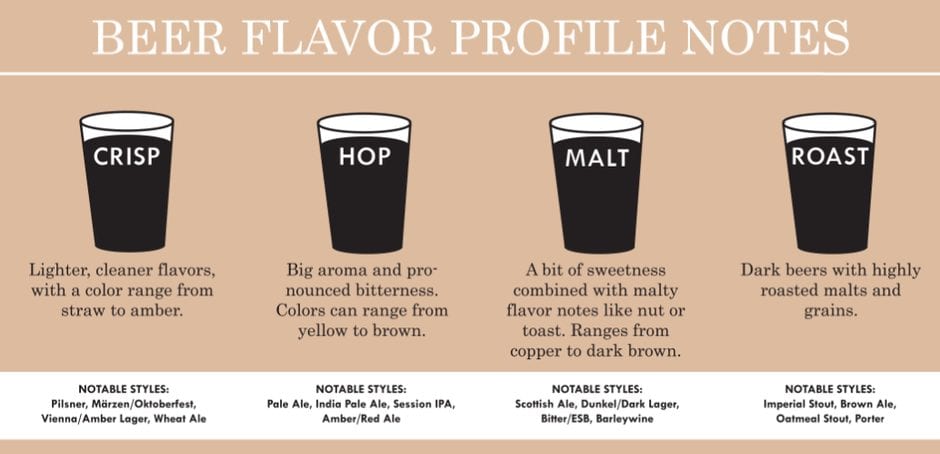The Different Beer Flavor Profiles (Part 1)
You don’t have to be a craft beer connoisseur to appreciate the complicated flavor profiles in your favorite craft beers. In fact, the more knowledge you have about the seven flavor profiles, the easier it’ll be to distinguish between the variety of styles out on the market. You’re also more likely to find a beer that fits your taste. We’ll outline Greg Engert‘s first four flavor categories of beer, using a handy infographic from CityLab as our guide. Have any questions? Feel free to comment below!

Crisp – Lighter, cleaner flavors, with a color range from straw to amber. A beer with a crisp flavor profile often incorporates fruit flavors or malted-accents to create a refreshing and light-bodied brew. A cold, crisp beer with a dry finish makes for the perfect summer drink – not too overpowering and perfect for beating the heat. This flavor profile is often associated with alcoholic ciders as well.
Notable styles: Pilsner, Märzen/Octoberfest, Vienna/Amber Lager, Wheat Ale
Hop – Big aroma and pronounced bitterness. Colors range from yellow to brown. Hops work as a spice component balancing out the malty sweetness of the beer. Harvested from a vine, the hop flower can add a variety of flavor profiles to any beer – floral, earthy, herbal, citrus, spicy, etc. Hops can vary depending on region and variety.
These brews are characterized by their bitter profile, exuding powerful earthy and herbal aromas. Beers with a large hop profile will have a strong malty-backbone to balance out the overall flavor. However, some brewers love to create beers with extreme “hoppy” flavor accents for the avid hoppy beer lover – often forgoing the sweet/bitter balance for an intense hoppy and bitter beer.
Notable Styles: Pale Ale, Indian Pale Ale, Session IPA, Amber/Red Ale
Malt – A bit of sweetness combined with malty flavor notes like nut or toast. Ranges from copper to dark brown. The malt profile in beers comes from the malted grains used in the brewing process, often adding “nuts, toffee, caramel, toast, and fruit” notes to the brew. The malted-accents of each beer varies depending on the type of grain used in the brewing process. These grains – barley, wheat, rye, oats, etc. – produce a sweet taste, a flavor derived from the fermentable sugars in the alcohol making process.
Different malt flavors can be used in a range of ales – including ales with hoppy profiles. Other malted beers include ones featuring dark roasts. These roasted ales feature the malts as a central flavor component.
Notable Styles: Scottish Ale, Dunkel/Dark Lager, Bitter/ESB, Barleywine
Roast – Dark beers with highly roasted malts and grains. Roasted-malt brews appear darker with a creamier, medium-to-heavy body. The grains used in the roasted-malt brewing process are baked uncovered at high temperatures, almost to the point of becoming charred. These dark beers often feature rich hints of coffee, hazelnut, and cocoa flavors. Brewers may incorporate dried dark fruits – cherries, plums, raspberries, etc. – to compliment the chocolaty notes in darker roasted beers.
Notable Styles: Imperial Stout, Brown Ale, Oatmeal Stout, Porter
Sources:
http://www.aperfectpint.net/blog.php/2010/03/malty-vs-hoppy-flavors-in-beer/
http://www.splendidtable.org/story/the-7-flavor-categories-of-beer-what-they-are-how-to-pair-them
http://www.citylab.com/navigator/2015/01/the-non-beer-snobs-guide-to-ordering-at-a-craft-beer-bar/384715/

